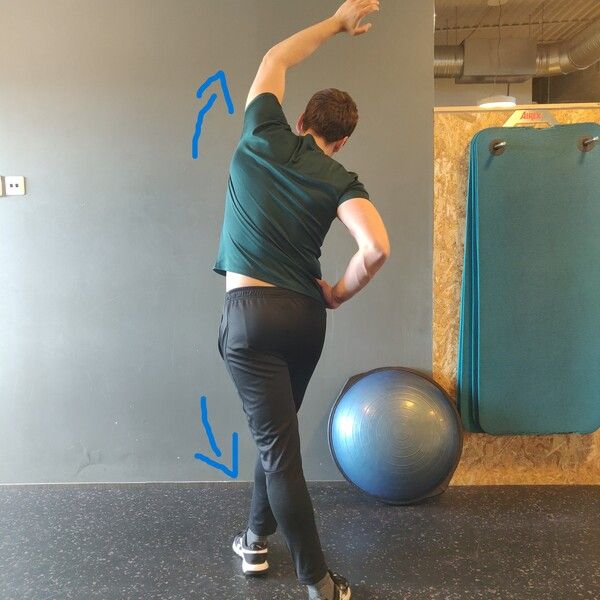Best Quadratus Lumborum Stretches For Relief
Is back pain holding you back? Unlocking the power of the quadratus lumborum (QL) might be the key to lasting relief and improved mobility. This often-overlooked muscle plays a crucial role in core stability and spinal health, and understanding how to properly stretch and strengthen it can significantly impact your overall well-being.
The quadratus lumborum, often referred to as the QL, is a deep abdominal muscle located in your lower back. It connects your lowest rib, the upper four lumbar vertebrae (bones in your lower spine), and the top of your pelvis. This strategic positioning means the QL is involved in a surprising range of movements, from bending and twisting to stabilizing your spine during everyday activities. When the QL is tight or strained, it can lead to lower back pain, hip pain, and even difficulty breathing. Fortunately, targeted stretches and strengthening exercises can help alleviate these issues and restore balance to your core.
| Muscle Name | Quadratus Lumborum (QL) |
|---|---|
| Location | Deep in the lower back, connecting the lowest rib, lumbar vertebrae, and pelvis. |
| Function | Lateral flexion of the spine (bending sideways), extension of the spine (bending backward), stabilization of the lumbar spine and pelvis. Aids in respiration (breathing). |
| Common Issues | Tightness, muscle strain, pain referred to the lower back, hips, and buttock. Can contribute to poor posture and limited mobility. |
| Exercises | Stretches: Side bends, QL stretch with yoga belt, rotational stretches. Strengthening: Side planks, bird-dog, back extensions. |
| Reference | Physiopedia: Quadratus Lumborum |
Now that we've established the QL's importance, let's dive into the specifics of stretching and strengthening this vital muscle. Stretching the QL is often the first line of defense against lower back discomfort. A simple yet effective stretch involves standing with your feet hip-width apart and gently bending to one side. Hold the stretch for 20-30 seconds, feeling the lengthening sensation along your side. Repeat on the other side. For a deeper stretch, try using a yoga belt or towel. Lie on your back with your knees bent and feet flat on the floor. Loop the belt around one foot, holding the ends of the belt in your hands. Extend the leg with the belt towards the ceiling, gently pulling on the belt to intensify the stretch in your QL.
Another valuable stretch involves lying on your side with your knees bent at a 90-degree angle. Reach your top arm overhead and gently twist your torso, bringing your top shoulder towards the floor. This rotational stretch targets not only the QL but also other surrounding muscles that contribute to lower back stability. Hold for 20-30 seconds and repeat on the other side.
Beyond stretching, strengthening the QL is crucial for long-term back health. Side planks are a fantastic exercise for building strength in your core, including the QL. Start by lying on your side with your elbow directly beneath your shoulder and your legs extended. Lift your hips off the floor, forming a straight line from your head to your feet. Hold for 30-60 seconds and repeat on the other side. To modify the exercise, you can lower your knees to the floor for added support. The bird-dog exercise also strengthens the QL while improving balance and coordination. Begin on your hands and knees, with your hands shoulder-width apart and your knees hip-width apart. Extend your right arm forward and your left leg back, maintaining a straight line from your fingertips to your heel. Hold for a few seconds, then return to the starting position. Repeat on the other side, alternating sides for 10-15 repetitions.
Incorporating back extensions into your routine further strengthens the QL and surrounding back muscles. Lie face down on a stability ball with your feet flat on the floor. Place your hands behind your head and slowly lower your chest towards the floor. Engage your back muscles to lift your chest back up to the starting position. Repeat for 10-15 repetitions. These strengthening exercises, combined with regular stretching, create a powerful synergy that can significantly improve your lower back health and overall mobility.
While these stretches and exercises can be beneficial for many, its important to listen to your body and stop if you feel any pain. If you experience persistent back pain, consult a qualified healthcare professional for personalized guidance and a comprehensive evaluation. They can assess your specific condition and recommend the most appropriate course of treatment.
Remember, taking care of your QL is an investment in your long-term well-being. By incorporating these stretches and strengthening exercises into your regular routine, you can unlock the power of this vital muscle, paving the way for a healthier, more mobile, and pain-free life.


